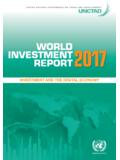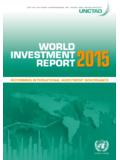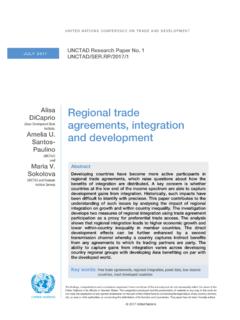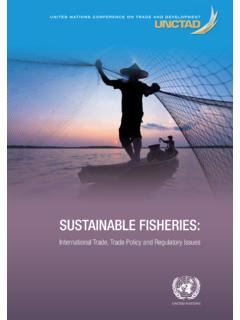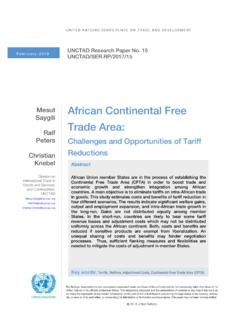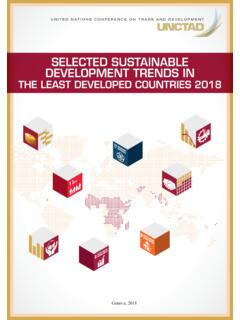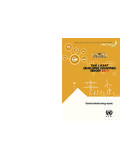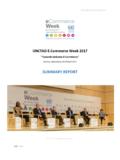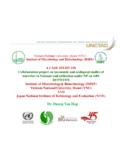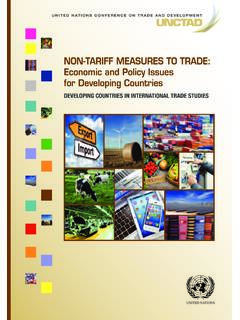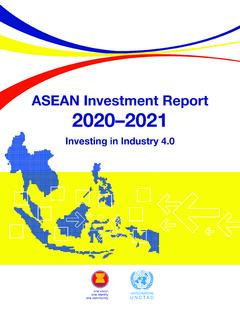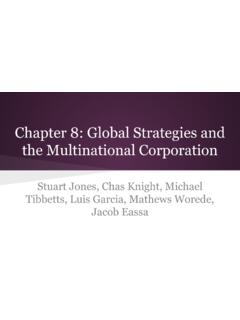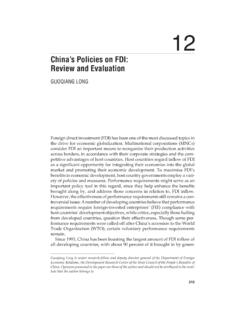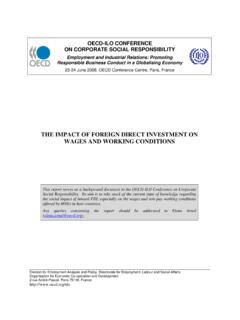Transcription of WORLD INVESTMENT REPORT2021
1 UNITED NATIONS CONFERENCE ON TRADE AND DEVELOPMENTOVERVIEW WORLD INVESTMENT REPORT2021 INVESTING IN SUSTAINABLE RECOVERYG eneva, 2021 UNITED NATIONS CONFERENCE ON TRADE AND DEVELOPMENTOVERVIEWWORLD INVESTMENT REPORT2021 INVESTING IN SUSTAINABLE RECOVERYiiWorld INVESTMENT Report 2021 Investing in Sustainable Recovery 2021, United NationsThis work is available through open access, by complying with the Creative Commons licence created for intergovernmental organizations, at designations employed and the presentation of material on any map in this work do not imply the expression of any opinion whatsoever on the part of the United Nations concerning the legal status of any country, territory, city or area or of its authorities, or concerning the delimitation of its frontiers or and reproductions of excerpts are allowed with proper publication has been edited Nations publication issued by the United Nations Conference on Trade and (Overview)iiiGlobal flows of foreign direct INVESTMENT have been severely hit by the COVID-19 pandemic.
2 In 2020, they fell by one third to $1 trillion, well below the low point reached after the global financial crisis a decade ago. Greenfield investments in industry and new infrastructure INVESTMENT projects in developing countries were hit especially is a major concern, because international INVESTMENT flows are vital for sustainable development in the poorer regions of the WORLD . Increasing INVESTMENT to support a sustainable and inclusive recovery from the pandemic is now a global policy priority. This entails promoting INVESTMENT in infrastructure and the energy transition, in resilience and in health WORLD INVESTMENT Report supports policymakers by monitoring global and regional INVESTMENT trends and national and international policy developments.
3 This year s report reviews INVESTMENT in the Sustainable Development Goals (SDGs) and shows the influence of INVESTMENT policies on public health and economic recovery from the concerted global effort is needed to increase SDG INVESTMENT leading up to 2030. The package of recommendations put forward by UNCTAD for promoting INVESTMENT in sustainable recovery provides an important tool for policymakers and the international development commend this report to all engaged in building a sustainable and inclusive nio Guterres Secretary-General of the United NationsPrefaceivWorld INVESTMENT Report 2021 Investing in Sustainable RecoveryThe COVID-19 pandemic caused a dramatic fall in global foreign direct INVESTMENT (FDI) in 2020, bringing FDI flows back to the level seen in 2005.
4 The crisis has had an immense negative impact on the most productive types of INVESTMENT , namely, greenfield INVESTMENT in industrial and infrastructure projects. This means that international production, an engine of global economic growth and development, has been seriously affected. The crisis has rolled back progress made in bridging the INVESTMENT gap achieved following the adoption of the SDGs. This demands a renewed commitment and a big push for INVESTMENT and financing in the SDGs. The main focus now is on the recovery process. But the issue is not only about reigniting the economy, it is about making the recovery more sustainable and more resilient to future shocks.
5 Given the scale and multitude of the challenges, we need a coherent policy approach to promote INVESTMENT in resilience, balance stimulus between infrastructure and industry, and address the implementation challenges of recovery plans. This report looks at INVESTMENT priorities for the recovery phase. It shows that for developing and transition economies, and LDCs in particular, the development of productive capacity is a helpful guide in setting INVESTMENT priorities and showing where international INVESTMENT can most contribute but also where it has been hit hardest during the pandemic. The report argues that five factors will determine the impact of INVESTMENT packages on sustainable and inclusive recovery: additionality, orientation, spillovers, implementation and report also points at specific challenges that will arise with the roll-out of recovery INVESTMENT plans and proposes a framework for policy action to address them.
6 The policy framework presents innovative actions and tools for strategic priority setting. For policymakers, the starting point is the strategic perspective, in the form of industrial development approaches. Industrial policy will shape the extent to which firms in different industries will be induced to rebalance international production networks for greater supply chain resilience and greater economic and social resilience. Our task today is to build forward differently. This will not be possible without reigniting international INVESTMENT as an engine of growth, and ensuring that the recovery is inclusive and thus that its benefits extend to all countries.
7 I hope that the policy framework for investing in sustainable recovery will inspire and reinvigorate efforts towards this goal. ForewordIsabelle DurantActing Secretary-General of UNCTADviWorld INVESTMENT Report 2021 Investing in Sustainable RecoveryThe WORLD INVESTMENT Report 2021 was prepared by a team led by James X. Zhan. The team members included Richard Bolwijn, Bruno Casella, Arslan Chaudhary, Joseph Clements, Hamed El Kady, Kumi Endo, K lm n Kalotay, Joachim Karl, Isya Kresnadi, Oktawian Kuc, Massimo Meloni, Anthony Miller, Kyoungho Moon, Abraham Negash, Yongfu Ouyang, Diana Rosert, Amelia Santos-Paulino, Astrit Sulstarova, Claudia Trentini, Joerg Weber and Kee Hwee support and inputs were provided by Gregory Auclair, Federico Bartalucci, Vincent Beyer, Ermias Biadgleng, Dominic Dagbanja, Luciana Fontes de Meira, Vicente Guazzini, Fang Liu, Sang Hyunk Park, Lisa Remke, Yvan Rwananga, Maria Florencia Sarmiento.
8 Rita Schmutz, Christoph Spennemann and R mi Pierre Vin , and by UNCTAD interns Cemile Av ar, Opemipo Omoyeni and Vanina Vegezzi. Comments and contributions were provided by Stephania Bonilla, Chantal Dupasquier, Alina Nazarova and Paul Wessendorp, as well as from the Office of the assistance was provided by Bradley Boicourt, Mohamed Chiraz Baly and Smita Lakhe. IT assistance was provided by Chrysanthi Kourti and Elena were edited by Caroline Lambert, and the manuscript was copy-edited by Lise Lingo. The design of the charts and infographics, and the typesetting of the report were done by Thierry Alran and Neil Menzies. Production of the report was supported by Elisabeth Anodeau-Mareschal and Katia Vieu.
9 Additional support was provided by Nathalie Eulaerts, Rosalina Goyena and Sivanla theme chapter of the report benefited from extensive advice and inputs from Jakob M llner and Paul Vaaler. The team is grateful for advice, inputs and comments, at all stages of the conceptualization and drafting process, from colleagues in international organizations and other experts, including Jesica Andrews, Hermelo Butch Bacani, Lawrence Bartolomucci, Monica Bennett, Henri Blas, Peter Buckley, Siobhan Clearly, Mussie Delelegn, Vivien Foster, Masataka Fujita, Yamlaksira Getachew, Tiffany Grabski, Aleksey Kuznetsov, Waikei Raphael Lam, Sarianna Lundan, Moritz Meier-Ewert, Juan Carlos Moreno-Brid, Rod Morrison, Lorenzo Nalin, Wim Naud , Kirill Nikulin, Patrick Osakwe, Oualid Rokneddine.
10 Harsha Vardhana Singh, Jagjit Singh Srai, Satheesh Kumar Sundararajan, Katharina Surikow, Justin Tai, Giang Thanh Tung, Visoth Ung and Giovanni Valensisi. The report benefited from collaboration with colleagues from the United Nations Regional Commissions for its sections on regional trends in chapter II, and comments received from the International Organization of Securities Commissions and the WORLD Federation of Exchanges on chapter officials of central banks, national government agencies, international organizations and non-governmental organizations also contributed to the INVESTMENT Report 2021 Investing in Sustainable RecoveryTABLE OF CONTENTSPREFACE.
